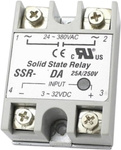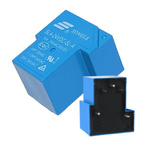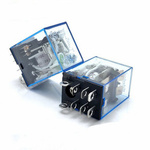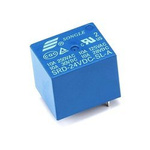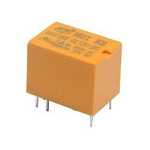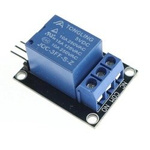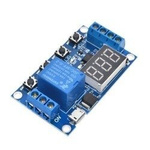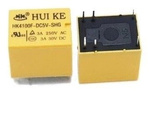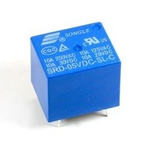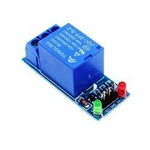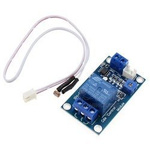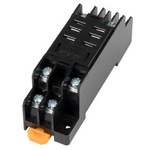Add products by adding codes
Relays
( quantity of products: 29 )Electric Relays - the basis of automation
Electrical Relays are an integral part of many devices and systems, playing a key role in their operation.
Different types of relays are used depending on the specific application.
For example, electromagnetic relays are often used in alarm systems where quick response is crucial. In turn solid-state relays, because of their performance and durability, they are ideal for industrial applications such as motor control. Whereas relay modules speed up and make it easier for us to build automation equipment.
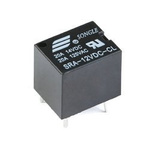
SONGLE SRA-5VDC-CL 20A - 5V - 5PIN T74 power relay - 14VDC 125VAC contacts

SONGLE SRA-24VDC-CL 20A - 24V - 5PIN T74 power relay - 14VDC 125VAC contacts
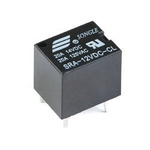
SONGLE SRA-12VDC-CL 20A - 12V - 5PIN T74 power relay - 14VDC 125VAC contacts

Relay module with timer - 0-10 seconds - contacts 10A/250V AC, or 10A/30V DC
Have you ever wondered how your home alarm system works, or how it is possible that your car only starts when you insert the right key into the ignition? The answer to these questions is simple - electrical relays are responsible for all of this.
1. Types of Electrical Relays and Their Applications
Electrical relays are an integral part of many devices and systems, playing a key role in their operation. Different types of relays are used depending on the specific application. For example, electromagnetic relays are often used in alarm systems where quick response is crucial. Solid-state relays, on the other hand, are ideal for industrial applications such as motor control due to their performance and durability. Below is a comparison table that shows the differences between the different types of relays:
Relay type | Application | Example |
|---|---|---|
Electromagnetic relay | Alarm systems | Car alarm |
Solid-state relay | Motor control | Motor in a washing machine |
Choosing the right relay is key to optimizing the performance of the device or system. Therefore, it is useful to know the differences between the different types of relays and their applications.
2. How an Electric Relay Works: Process and Mechanism
An electrical relay is a device that plays a key role in many systems and devices. It works on the principle of changing state under the influence of a change in current or voltage magnitude. The main component of the relay is the coil, which under the influence of the current flowing through it produces a magnetic field. This magnetic field attracts the core, which closes or opens the relay contacts.
Comparing electromagnetic relay and static relay, several important differences can be noted. An electromagnetic relay works on the principle of mechanical attraction, while a static relay uses semiconductors to transmit signals. Below is a comparison table:
Electromagnetic Relay | Static Relay | |
|---|---|---|
Method of operation | Mechanical attraction | Use of semiconductors |
Speed of operation | Slower | Faster |
Size | Greater | Smaller |
While the electromagnetic relay is larger and works slower, the static relay is smaller and works faster. The choice between the two depends on the specifics of the system or device in question. Electromagnetic relays are often used in systems that require more power, while static relays are ideal for applications that require fast action and small size.
3. Comparison of Electrical Relays: Electromagnetic vs. Semiconductor
When analyzing the differences between electromagnetic and solid-state relays, it is worth noting several key aspects. Electromagnetic relays are characterized by simplicity of construction and reliability, which translates into their long service life. On the other hand, solid-state relays offer higher switching speeds, which can be crucial in some applications.
In terms of energy efficiency, solid-state relays have a definite advantage. Thanks to the absence of moving parts, they minimize energy loss, resulting in higher efficiency. However, electromagnetic relays, due to their simplicity, are often chosen for applications where reliability and durability are key.
In summary, the choice between electromagnetic and solid-state relays depends on the specifics of your application. Electromagnetic relays are ideal for applications where reliability and durability are key, while solid-state relays are preferred where switching speed and energy efficiency are important.
4. Key Features and Advantages of Electrical Relays
Electrical relays are extremely versatile, making them an indispensable component in a wide variety of systems and devices. The advantage of relays is their ability to control large loads, which is particularly useful in the industry. Being able to control circuits with high voltages and currents, they can be used in a wide range of applications, from simple home appliances to advanced industrial systems.
Electric relays are also characterized by high reliability and long service life. They are resistant to a wide variety of factors, such as changes in temperature, humidity and vibration, making them ideal for many harsh environments. In addition, the relays are easy to operate and maintain, resulting in lower operating costs. In our guide find more information on selecting and using electrical relays.
5. Choosing the Right Electrical Relay: Practical Tips
Regardless of the application, choosing the right electrical relay is key to ensuring efficient and safe system operation. Parameters such as voltage, current, load type and operating environment are essential to consider when selecting. Undefined variables, such as anticipated working conditions, can also influence the decision to choose a.
When selecting a relay, it is important to understand how different types of relays work in different situations. For example, electromechanical relays are ideal for high-voltage applications, while solid-state relays are better for high-speed switching applications. Understand the specifications and limitations of each relay type is key to selecting the most suitable for a given application.
Finally, it is worth noting quality and reliability of the selected relay. By choosing a relay from a reputable manufacturer, you can minimize the risk of failure and ensure long-term, reliable system operation. Remember, choosing the right relay is an investment in the safety and efficiency of your system.
6. Most Common Problems with Electrical Relays and How to Solve Them
When working with electrical relays, we often encounter some problems. The most common problems are related to the improper operation of the, which can result from a number of different causes. This may be due to relay failure, improper connection or even power supply problems. Solving these problems often requires a deep understanding of how relays work and the ability to diagnose problems.
Relay failure is one of the most common problems that can be encountered. This can be caused by overload, overvoltage or even corrosion. To solve this problem, first carefully inspect the relay for visible damage. If the relay is defective, usually the best solution is to replace it. However, if the relay appears to be in good condition, the problem may lie elsewhere.
Power problems are another common problem. If the relay does not receive adequate voltage, it may not function properly. If this is the case, check the power source and make sure it provides the correct voltage. If the power supply is fine, the problem may lie in the relay itself. In this case, it may be necessary to consult a professional.
Summary, problems with electrical relays can be due to a variety of reasons, but the most common are relay failure or power supply problems. Solving these problems requires an understanding of how relays work and the ability to diagnose problems. In case of difficulties, it is always a good idea to consult a professional.
Frequently Asked Questions
Are electrical relays safe to use?
Electrical relays are safe to use, provided they are properly installed and operated. Always follow safety precautions, such as turning off power before working with the relay.Are electrical relays durable?
Yes, electrical relays are usually very durable and can operate for many years without failure. However, their lifespan depends on many factors, such as working conditions, frequency of use and proper maintenance.What are the most common applications of electrical relays?
Electrical relays are widely used in many fields such as industrial automation, alarm systems, building automation, as well as in electronic devices such as televisions, computers and audio equipment.Are electrical relays easy to install?
Installation of an electrical relay can be simple or complex, depending on the model and application. In some cases it may be necessary to use the services of a professional. Always follow the manufacturer's instructions.Are electric relays energy efficient?
Electrical relays are typically designed to minimize power consumption. However, their energy efficiency depends on a number of factors, such as the type of relay, its application and how it is used.






